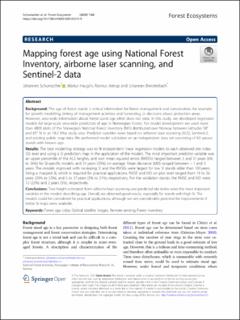| dc.description.abstract | Background The age of forest stands is critical information for forest management and conservation, for example for growth modelling, timing of management activities and harvesting, or decisions about protection areas. However, area-wide information about forest stand age often does not exist. In this study, we developed regression models for large-scale area-wide prediction of age in Norwegian forests. For model development we used more than 4800 plots of the Norwegian National Forest Inventory (NFI) distributed over Norway between latitudes 58° and 65° N in an 18.2 Mha study area. Predictor variables were based on airborne laser scanning (ALS), Sentinel-2, and existing public map data. We performed model validation on an independent data set consisting of 63 spruce stands with known age. Results The best modelling strategy was to fit independent linear regression models to each observed site index (SI) level and using a SI prediction map in the application of the models. The most important predictor variable was an upper percentile of the ALS heights, and root mean squared errors (RMSEs) ranged between 3 and 31 years (6% to 26%) for SI-specific models, and 21 years (25%) on average. Mean deviance (MD) ranged between − 1 and 3 years. The models improved with increasing SI and the RMSEs were largest for low SI stands older than 100 years. Using a mapped SI, which is required for practical applications, RMSE and MD on plot level ranged from 19 to 56 years (29% to 53%), and 5 to 37 years (5% to 31%), respectively. For the validation stands, the RMSE and MD were 12 (22%) and 2 years (3%), respectively. Conclusions Tree height estimated from airborne laser scanning and predicted site index were the most important variables in the models describing age. Overall, we obtained good results, especially for stands with high SI. The models could be considered for practical applications, although we see considerable potential for improvements if better SI maps were available. | en_US |

